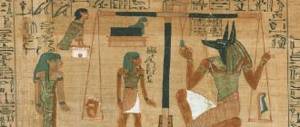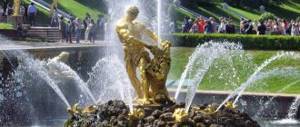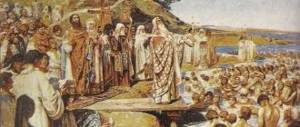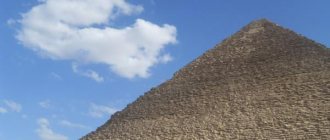Summary of the General History lesson in 6th grade “Crusades”
Methodological development of a history lesson in 6th grade.
The purpose of the lesson:
- Students will be able to name the reasons for the Crusades in the East.
- Students will be able to describe the actions of the First Crusade using a wall map and documents.
- Students will be able to talk about the results of the first Crusades.
Basic Concepts
: Crusaders, spiritual and knightly orders.
Key dates
:
1095 g
.- an appeal from the Pope calling for the liberation of Jerusalem from the infidels.
1096-1099
. – First Crusade.,
1099 g
.
– capture of Jerusalem by the Crusaders ,
1187
– the successful actions of Saladin, the loss of Jerusalem by Christians.
1204 g
.- Siege and capture of Constantinople by the crusaders.
Equipment:
Computer presentation “Crusades”, wall map “Crusades”, documents: “Capture of Jerusalem by the Crusaders”, “Siege and capture of Constantinople by the Latins”.
During the classes
1.Checking homework.
The teacher asks the question: What is the meaning and significance of the rivalry between the popes and German emperors?
( dispute about investiture - introduction to a church position. The pope won the dispute, his power was now higher than secular. The power of the church lay in its influence on believers. The more believers, the higher the authority of the church. The population of fragmented Europe - Christians - were under power popes. In addition, the pope crowned emperors and could excommunicate them. And the power of the emperor did not even extend to all subjects of the empire, because in the Middle Ages there was a saying: “My vassal...”)
P. Presentation of new material.
Plan.
- The beginning of the Crusades. Driving forces.
- First Crusade.
- What did the Crusades lead to?
- Reconquest of Jerusalem by Saladin.
- The end of the era of the Crusades
1. The beginning of the Crusades. Driving forces.
a) Working with the class
The teacher conducts a short survey among the students, asking who knows what about the Crusades. After this, the teacher says that the Crusades are one of the most striking and unique events in the history of Medieval Europe, that it was in them that many ideas about chivalry and chivalric deeds were born.
Writing in notebooks
lesson topics. (slide No. 1)
Teacher's word
IN 1095
The Pope addressed the believers with a call to liberate Jerusalem from the infidels. Christian feeling was sometimes greatly offended by manifestations of Muslim fanaticism. (slide No. 2,3)
Writing in notebooks
:
1095 g…
.
b) A skit with the participation of class students, illustrating the call of the pope, the composition and goals of the participants in the campaign (Appendix No. 1).
The teacher conducts a conversation on the following questions:
1. What did the Pope call for?
2. Who went on a hike?
3. What are the goals of the participants in the campaign? ( The goal of the campaign was the liberation of Palestine from Muslims, which was considered the Holy Land, since many events of the Old and New Testaments were connected with it, where Jesus Christ preached and was crucified. The liberation of the Holy Sepulcher from the hands of infidels (then there are non-Christians
) –
Muslims were perceived as a grandiose feat in the name of faith and church, for which one could earn forgiveness of sins and salvation after death
.)
c) As a result of the conversation, task is completed in workbook No. 63 on p. 41.
Who took part in the Crusades? What were the reasons that prompted these people to go to the East?
| Participants of the Crusades | Causes |
| Clergy, dad | New lands, income. To finally consolidate his position as the head of the entire Christian world. |
| Large feudal lords | Loud titles, conquest of new lands |
| Knights | Get new lands, capture rich trophies. |
| Merchants | Source of oriental goods, large income from trade. |
| Peasants | Liberation from dependence, obtaining your own allotment for cultivating the land. |
Checking the task (Slide No. 4.)
2.The First Crusade.
a) This was not the first time that Europeans went on a campaign against Muslims. Name the emperor who made the campaign for Perenea, which was also considered a godly deed.
(Charlemagne
).
How do you see the difference between these events? ( Charles went on a campaign on his own initiative, as the sovereign of a single and powerful power. The crusades were inspired by the call of the pope in Europe, fragmented among different sovereigns. This is evidence of the increased strength and authority of the Catholic Church
)
b) The teacher's word.
Participants in the campaign sewed a cross onto their clothes as a sign of accepting the vow to liberate the Holy Sepulcher, referring to the words of the New Testament “And whoever does not bear his cross and follow Me cannot be my disciple” (Gospel of Luke 14:27). (Slide No. 5)
Crowds of European poor people were the first to go on a campaign.
They managed to get to Asia Minor, but there they were defeated in the first clash with the Saracens, as the Europeans called the Arabs first, and then all Muslims.
The knights set off on the campaign later due to long and thorough preparations.
Slide number 6
Entry in notebooks : 1097-1099
.- First Crusade
c) Working with the map. Show direction of the First Crusade, Constantinople, Jerusalem. (slide number 7)
d) Working with the document: (Appendix No. 2) “The Capture of Jerusalem by the Crusaders. Question for the document: How does the author describe the actions of the defenders of the fortress and the actions of the crusaders? (slide number 8.)
The teacher summarizes: Thus, after the First Crusade, Europeans established themselves in Palestine.
- What did the Crusades lead to?
a) The teacher says:
After the capture of Jerusalem, the Kingdom of Jerusalem and several vassal principalities were founded in Palestine.
New knights and settlers began to arrive in Palestine. The Crusaders built fortified castles and erected new temples in Jerusalem and other cities. Settlers received land, rulers received new titles. (slide no. 9,10.)
Over time, the spiritual knightly orders became the largest and most well-organized force in the Kingdom of Jerusalem. These were brotherhoods created like monastic ones, the members of which were knights. (slide number 11.)
Representatives of spiritual knightly orders. (slide number 12.)
b) Independent work with the textbook
Students read the Details section of The Three Orders of Knighthood on pp. 149-150 and answer question 1 orally after the section.
Writing in notebooks
: spiritual knightly orders - Hospitallers, Templars (templars), German (Teutonic) order.
After this, complete the task in workbook No. 64 on pp. 41-42. (Which spiritual knightly orders are we talking about? (You can do this task at home).
- Reconquest of Jerusalem by Saladin.
a ) The teacher's word
However, the power and position of Europeans in the Holy Land was not strong. In order to stay in Palestine, the Europeans had to constantly confront the entire Muslim world, which surrounded the crusaders on all sides. For this purpose, in 1147
. The Second Crusade was proclaimed, which ended in nothing; the knights never reached Palestine. (slide No. 13)
Notebook entry: 1147 – 1149. - Second Crusade.
b)Work with the class
Look at the map of Palestine and evaluate who was easier to organize the transfer of troops - the Crusaders or the Muslims? ( The Crusaders needed to hold a narrow strip along the sea, where additional troops could be delivered only by ships, or by fighting their way through the Muslim possessions in Asia Minor. The Muslim possessions stretched on all sides of Palestine. Therefore, their troops did not experience great difficulties in attacking the Crusaders. )
c ) Teacher's word
The Crusaders suffered more and more failures. In 1187
. The Egyptian Sultan Salah ad-Din (Saladin) forced Christians to leave Jerusalem. The Kingdom of Jerusalem ceased to exist. (slide no. 14,15.)
d) Watching a video clip from the film “Kingdom of Heaven” about the fall of Jerusalem.
Writing in notebooks
:
1187
g. - the successful actions of Saladin, the loss of Jerusalem by Christians.
- The end of the era of the Crusades
.
a) Teacher's word
In response to this, the Third Crusade was proclaimed, which was led by the German Emperor Frederick Barbarossa, the English King Lionheart and the French King Philip P. However, this campaign did not lead to the desired goal - the crusaders managed to capture the important fortress of Acre, but Jerusalem was never recaptured . (slide number 16)
During the Fourth Crusade 1202-1204. The Crusaders captured the capital of Byzantium, Constantinople, and subjected it to terrible destruction. (slide no. 17-18)
The teacher reports the end of the era of the Crusades (slide 19.)
III.Secure the material
. Students complete the test (slide No. 20-24).
IV . Summing up the lesson, grading in the journal.
The teacher invites students to independently summarize the lesson and determine the effectiveness of the Crusades. If students find it difficult, the teacher does it himself:
At the call of the Pope, knights and commoners went to defend the Holy Sepulcher. They expected to find a better life in the Middle East. So they were motivated not only by religious fanaticism. The small armies of the crusaders could not compete with the troops of the powerful Muslim states. European military successes were the exception rather than the rule. (slide number 25).
V.Homework :
- Read paragraph 14-15 Complete tasks No. 70 in the workbook, continue working on the project “The Life of a Medieval Knight”
Appendix 2
Siege and capture of Jerusalem
The document is quoted from the “History of the Holy War” by Archbishop William of Tire (date of life - approximately 40-90s of the
12th ).
The city of Jerusalem lies on two hills...
In the year... one thousand ninety-nine
(1099), on the seventh day of the month of June, our troops encamped near the city. They say that in total, without distinction of gender, age and condition, there were up to 40 thousand people in the camp; Of these, there are barely 20 thousand people on foot and 1500 horsemen capable of bearing arms; the rest all consisted of unarmed rabble, sick and paralyzed.
In the city, they said, there should have been 40 thousand brave and well-armed troops, for many people gathered in the city from neighboring cities and from the surrounding area...
On the fifth day (June 12) ... the heralds publicly announced that everyone, young and old, should arm themselves and stock up on a shield in order to be ready for an attack on the city; the order was carried out. Everyone rose up unanimously and surrounded the besieged part of the city. The inhabitants retreated in fear to the inner walls from the outer ones, which were broken by ours, and lost all hope of further resistance.
When the day arrived (June 14), the entire army, fully armed, set out from the camp to begin the attack, as had been announced. Everyone firmly decided to either sacrifice their lives for Christ or return Christian freedom to the city. In the whole army there was not an old man, or a sick person, or a minor youth who did not burn with a sacred thirst for battle; even women forgot about their gender and their weakness and grabbed weapons, taking on men’s labor that exceeded their strength. Having entered the battle with such unanimity, they tried to bring the manufactured machines closer to the walls in order to overcome those who fought back against them, standing on the walls and towers. The besieged, having decided to resist to the last extreme, fired spears with countless arrows, threw stones from hand or machine and tried to repel ours.
Appendix 3.
Test
- Why did the Crusades begin?
a) the desire of the participants in the campaigns to liberate the Holy Land
b) the desire of participants to get acquainted with the traditions of Eastern countries.
C) the desire to open new trade routes.
- When did the first Crusade take place?
a) 1095-1098
b) 1094-1097
c) 1097-1099
- Who took part in the Crusades?
a) peasants and townspeople
b) knights
c) large feudal lords
d) clergy
e) everything listed under a), b), c). G).
- What was the name of the main crusader state created on the coast of Syria and Palestine?
a) Kingdom of Jerusalem
b) Teutonic state
c) Templar Kingdom
- Who are the Saracens?
a) residents of Sicily
b) African peoples
c) Byzantines
d) Arabs.
Presentation on the history of the Crusades
Crusades
Crusades
a series of military campaigns in the Middle East undertaken by Western European Christians in order to liberate the Holy Land from Muslims. The Crusades were the most important stage in the history of the Middle Ages. All social strata of Western European society were involved in them: kings and commoners, the highest feudal nobility and clergy, knights and servants. People who took the crusader vow had different motives: some sought to get rich, others were attracted by a thirst for adventure, and others were driven solely by religious feelings.
Who are the “crusaders”?
The name “crusaders” appeared because participants in the crusades sewed crosses onto their clothes. It was believed that the participants in the campaign would receive forgiveness of sins, so not only knights, but also ordinary residents and even children went on campaigns
Clermont Cathedral
church council convened by Pope Urban II in France
city of Clermont (modern
Clermont-Ferrand) and began on November 18, 1095 to resolve church administrative and church political issues
Clermont Cathedral
On November 26, 1095, after the end of the meetings of the Council of Clermont, in the face of the nobility and clergy, Pope Urban II made a passionate speech, calling on those gathered to go to the East and liberate Jerusalem from Muslim rule, promising the participants of the crusade absolution, freedom from debts, etc.
First Crusade
(1096–1099)
The 1st Crusade began in 1096. It involved several feudal armies, each with its own commander-in-chief. They arrived in Constantinople by three main routes, by land and sea. The campaign was led by feudal barons, including Duke Godfrey of Bouillon, Count Raymond of Toulouse and Prince Bohemond of Tarentum. Formally, they and their armies obeyed the papal legate, but in fact they ignored his instructions and acted independently.
First Crusade (results) (1096-1099)
At the end of the 1st Crusade, four Christian states were founded in the Levant:
- County of Edessa
- Principality of Antioch
- County of Tripoli
- Kingdom of Jerusalem
Second Crusade
(1147-1149)
In 1144 Edessa was captured by the Muslim ruler of Mosul, Zengi.
The head of the Cistercian monastic order, Bernard of Clairvaux, convinced the German Emperor Conrad III and King Louis VII of France to undertake a new crusade.
Conrad III
Louis VII
Second Crusade (results)
The forces that were able to attract participation in the campaign were enormous, but due to the lack of cooperation and a well-thought-out campaign plan, the campaign ended in complete failure.
Third
Crusade
The 3rd Crusade was led by the Holy Roman Emperor Frederick I Barbarossa, the French king Philip II Augustus and the English king Richard I the Lionheart. The German emperor drowned in Asia Minor. Philip II Augustus, under the pretext of illness, returned to Europe to try, in the absence of Richard I, to take away the Duchy of Normandy from him.
Frederick I Barbarossa
Philip II Augustus
Richard I the Lionheart
Third
Crusade (results)
Richard the Lionheart remained the only leader of the crusade. The exploits he accomplished here gave rise to legends that surrounded his name with an aura of glory. Richard recaptured Acre and Jaffa from the Muslims and concluded an agreement with Salah ad-din on unhindered admission of pilgrims to Jerusalem. But the former Kingdom of Jerusalem remained under Muslim rule. Also in 1191, Cyprus was conquered, where as a result an independent Kingdom of Cyprus arose, which existed until 1489.
Siege of Acre
Siege of Jaffa
Fourth Crusade (1202–1204)
The organizer was Pope Innocent III.
According to the initial agreement, the Venetians undertook to deliver the crusaders by sea to the shores of the Holy Land and provide them with weapons and provisions. But for this they demanded an exorbitant fee - 85 thousand marks. Due to the fact that the crusaders could not pay the bill, the ruler of Venice persuaded the knights to attack Constantinople
Fourth Crusade (results)
In 1204, the crusaders broke into Constantinople. They plundered the city for three days starting on April 13, 1204. The greatest cultural values were destroyed, and many Christian relics were plundered. In place of the Byzantine Empire, the Latin Empire was created, which lasted until 1261
Children's Crusade
The most tragic of attempts to return the Holy Land. The religious movement, which originated in France and Germany, involved thousands of peasant children who were convinced that their innocence and faith would achieve what adults could not achieve by force of arms. They reached Rome (via the Alps) and the city's rulers sent them back. Some of the children drowned, others died on the way to Rome from hunger, and the rest of the children died from cold.
Results of the Crusades
Christian military expeditions to the Middle East ceased after the Muslims took Acre in 1291.
Trade revived in Europe, new crops and Arab inventions appeared.
There were 8 crusades to Palestine, and the Children's Crusade should also be added. After the Crusaders were expelled from Palestine, the Crusades continued in Europe





